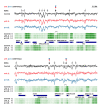Clustered regulatory elements at nucleosome-depleted regions punctuate a constant nucleosomal landscape in Schizosaccharomyces pombe
- PMID: 24256300
- PMCID: PMC4046669
- DOI: 10.1186/1471-2164-14-813
Clustered regulatory elements at nucleosome-depleted regions punctuate a constant nucleosomal landscape in Schizosaccharomyces pombe
Abstract
Background: Nucleosomes facilitate the packaging of the eukaryotic genome and modulate the access of regulators to DNA. A detailed description of the nucleosomal organization under different transcriptional programmes is essential to understand their contribution to genomic regulation.
Results: To visualize the dynamics of individual nucleosomes under different transcriptional programmes we have generated high-resolution nucleosomal maps in Schizosaccharomyces pombe. We show that 98.5% of the genome remains almost invariable during mitosis and meiosis while remodelling is limited to approximately 1100 nucleosomes in the promoters of a subset of meiotic genes. These inducible nucleosome-depleted regions (NDR) and also those constitutively present in the genome overlap precisely with clusters of binding sites for transcription factors (TF) specific for meiosis and for different functional classes of genes, respectively. Deletion of two TFs affects only a small fraction of all the NDRs to which they bind in vivo, indicating that TFs collectively contribute to NDR maintenance.
Conclusions: Our results show that the nucleosomal profile in S. pombe is largely maintained under different physiological conditions and patterns of gene expression. This relatively constant landscape favours the concentration of regulators in constitutive and inducible NDRs. The combinatorial analysis of binding motifs in this discrete fraction of the genome will facilitate the definition of the transcriptional regulatory networks.
Figures






References
Publication types
MeSH terms
Substances
LinkOut - more resources
Full Text Sources
Other Literature Sources
Molecular Biology Databases
Miscellaneous

